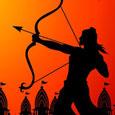Celebration of Dusshera
India is a vast multicultural land and hence, the celebration of any festival in the country differs from region to region. And this holds true for Dusshera as well. Know how Dusshera , the tenth and final day of the Navratri festival is celebrated across different parts of India. If you like this informative article on Celebration of Dusshera just click here and refer this page to your friends and near ones. Celebrate a wonderful Dusshera with your loved ones. Happy Dusshera!
Dusshera Celebration
Dusshera or Dasara or Vijaya Dashmi is one of the most popular Hindu festivals celebrated with great enthusiasm across India. As the time of its observance marks the close of the monsoon season, it is naturally a time for the recommencement of joyful festivals of all kinds. In many Indian states, Dusshera is the main festival. Though the occassion is celebrated everywhere across the country, it is celebrated with greater fanfare in places like Kullu in Himachal Pradesh, Varanasi in Uttar Pradesh, Mysore in Karnataka and in West Bengal. It is the climax of nine day long festivities during the Navaratri.
In Varanasi, Dusshera is celebrated in a sacred and joyous manner. The killing of Ravana by Lord Rama is enacted here in a beautiful way by local actors. Huge effigies of the ten-headed Ravana, his brother Kumbhakarna and his son Meghnada are placed in open spaces. A little distance away an enclosure is made which represents Lanka(Ceylon), Ravana's kingdom. Here the principal events of the rescue of Sita by Rama, as recorded in the Ramayana, are acted. Little boys dress up to play the parts of the other characters like the monkey soldiers of Ramachandra and of course, Hanuman the monkey-general. After the effigies have been set up, local actors dressed as Lord Rama, his consort Sita and his brother Lakshman arrive. The actor dressed as Lord Rama shoots an arrow of fire at the navel of Ravana which also serves to burn the other effigies, all of which are stuffed with explosive material. As the huge structures burn with deafening blasts, shouts of merriment and triumph arise from the spectators. Thereupon, Lord Rama rescues his consort Sitadevi and carries her off in a chariot with further applause. With the burning of the effigies, the assembled people are asked to burn the evil within them, and thus follow the path of virtue and goodness, bearing in mind the example of Ravan, who was destroyed for his evil ways despite having might and monarchy. Fairs are usually held on this occasion with lots to eat, buy and enjoy. Similar celebrations take place annually in other parts of North India on the Dusshera day.
In the southern, eastern and western parts of India, the festival of Navaratri culminates with Dusshera and commemorates the legend of the victory of Goddess Durga over the demon Mahishasura. The vanquishing of Mahishasura is believed to have occured near the present day city of Mysore in Karnataka.
Dusshera is nowhere celebrated in as grand a manner as in Mysore. The south Indian city of Mysore is synonymous with its annual Dusshera procession. In Mysore, Dusshera is popularly known as Dasara and the celebrations date since about 300 years ago when Raja Wodayar came to the throne of Mysore. He celebrated the festival on a royal scale, and after him, year after year the Dasara has gained in splendour, entertainment and attractiveness. The royal family of Mysore worships Goddess Durga as Devi Chamundeshwari, their patron Goddess. After weeks of feverish preparations, a spectacular procession of floats, entertainers, and elephant wends its way through the streets of the city, complete with the erstwhile scion of the Mysore royal family astride an elephant.
In South India, Dusshera is also the time when little children are ceremonially initiated into the learning of alphabets, a ritual known as Vidyarambha. In West Bengal, it is known as Vijaya Dashami and is an occassion when friends and relatives exchange visits thus building up an atmosphere of cordiality.
For artisans across North India, it is the time to polish the instruments of their profession. Many people use this time as an opportunity to clean, plaster and whitewash their houses and generally put things in order.
In the rural areas, figurines of Goddess Durga are made out of cowdung. These are decorated beautifully and placed on the walls of houses. When the idols dry up, offerings are made and barley is sown before them. On the eighth or ninth day the idols are thrown into a river or pond accompanied by jayaddhani (victory-cries).
In Kullu, the capital town of the Kullu District of Himachal Pradesh, Dusshera witnesses exuberant festivities for one whole week. The history of Kullu Dusshera dates back to the 17th century when the local King Jaganand brought an idol of Lord Raghunath from Ayodhya and installed it on his throne as a mark of penance. After this Lord Raghunath came to be known as the ruling deity of the Kullu Valley. The Dusshera celebrations of Kullu commence nearly ten days in advance. The week-long festivities come to an end with the sacrifice of a buffalo, a rooster, a lamb, a fish and a crab.
The Dusshera day is regarded as an auspicious occassion to launch new ventures. It has also always been special to the military classes, who consider it auspicious to set out on an expedition just after the festival.

 Ram Navami
Ram Navami Passover
Passover Good Morning
Good Morning